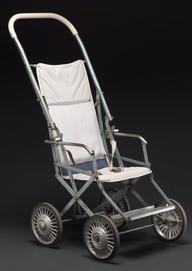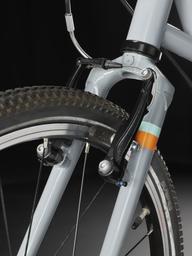Shooting Brake
This Shooting Brake was made by Peter Reid coachbuilders in Perth, Scotland, between 1825 and 1875. A large carriage that includes two tall front seats, and a large open back area with inward facing seating all around the sides (approximately fitting up to 10 passengers), which is accessed via two side facing half-doors. The seating is covered with a brown/tan padding, and the exterior of the carriage's body is painted entirely in black.
The black metal undercarriage has spoon brakes installed, and the carriage has no noticeable internal storage spaces. The wheels have hub caps which are engraved “Reid, Perth”.
Brakes refer to any carriage chassis designed to break in young horses and train them. They were often indistinguishable from, and interchangeably described as, wagons. In the 19th century onwards, shooting brakes became popular, using the same body of brakes but adding numerous seats in the back. The term ‘shooting brake’ evolved from this redesign, which made brakes very useful in carrying sportsmen, huntsman, and gamekeepers with their guns and dogs.
The gamekeeper would typically be the one driving the brake, with the sportsmen riding in the back with their guns and their dogs riding alongside. Shooting brakes remained popular into the early 20th century.
Like other carriages, shooting brakes had a distinct visual style that was carried over into automobile design. Cars with shooting brake body styles are loosely defined and are often referred to as ‘station wagons’ or ‘estate cars’ which typically feature two passenger doors with a wide body type and an extended rearward roof. Shooting brake or ‘station wagon’ style cars have remained popular throughout the 20th and 21st century.
This shooting brake was built sometime between 1825 and 1875 by Peter Reid, a Scottish coachbuilder established in Perth in 1797. Not much is known about the clientele of this coachbuilder, but an advertisement from 1899/1900 stated that Reid was given patronage by various notably figures, including His Royal Highness the Duke of Saxe-Coburg and Gotha, His Royal Highness the Prince of Carignan of Italy, His Highness the Maharajah Dhuleep Singh, and Duke of Fife. Reid made many styles of carriages, such as wagons, cee-spring carriages, and landaus.
- Measurements:
-
overall: 2300 mm x 2000 mm x 3800 mm,
- Materials:
- wood (unidentified) , metal (unknown) , paint , leather , textile and brass (copper, zinc alloy)
- Object Number:
- 1938-587 Pt1
- type:
- brake






